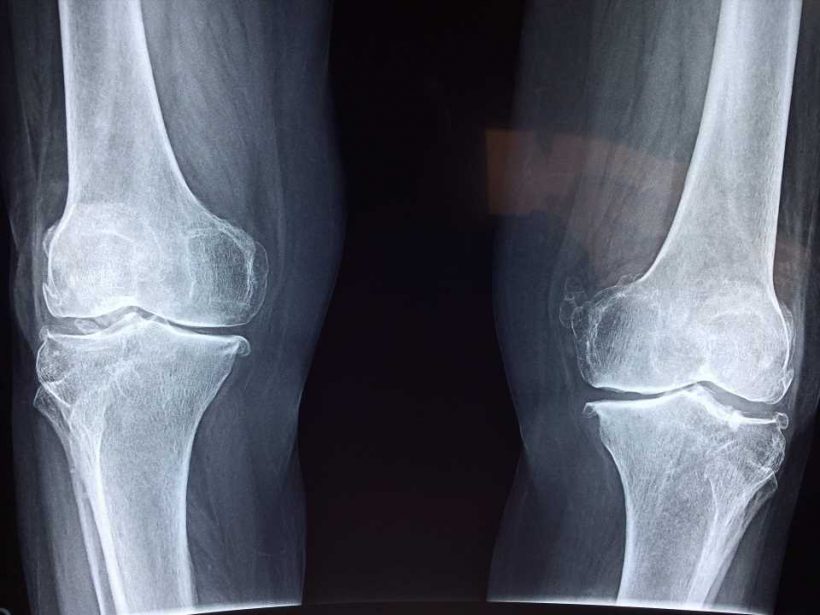
Untreated knee cartilage defects can lead to osteoarthritis, with symptoms such as continuous pain, stiffness, and reduced mobility. Current treatments for cartilage defects are limited to lesion sizes and specific age groups. Cartilage resurfacing implants are a promising alternative treatment for middle-aged patients who are no longer suitable for regenerative treatments, but are too young for a total knee replacement. The success of an implant is measured by looking at the friction, lubrication, and wear (tribological properties) experienced by the part in the body. Alicia Damen’s Ph.D. research looked at the development of two new cartilage resurfacing implants to treat cartilage defects and investigated their tribological properties.
Articular cartilage in the knee transmit loads and provides a smooth, lubricated surface for articulation in the knee joint. So, putting it simply, such cartilage is important for ease of motion. Thus, ultralow friction and enhanced lubrication are essential features of healthy articular cartilage in the knee joint.
However, when damaged cartilage is replaced by implants, such as focal knee resurfacing implants, their frictional properties need to be sufficient to ensure that the opposing cartilage is not further damaged during sliding or gliding. This depends on various aspects of the knee, such as cartilage and synovial fluid composition. And for her Ph.D. research, Alicia Damen set out to explore these aspects.
Cartilage composition
First, Damen looked at the importance of cartilage composition by showing that two cartilage resurfacing implants, one made from cobalt chrome and the other made from non-degradable poly carbonate-urethane (PCU), performed well when moved against healthy smooth cartilage. However, over time, this caused further damage when the opposing cartilage was arthritic.
Second, Damen assessed whether the implants themselves had been roughened over time in vivo as this could impair their performance. Detailed surface profilometry analysis showed that the surface texture of one cobalt chrome implant and two types of PCU implants, each with different stem stiffnesses, changed in different ways. Here, the stem is part of the implant that helps to fix the implant in the bone. This revealed that distinct wear mechanisms depend on both the surface material and the stiffness of the stem.
These stiff, non-resorbable implants do not adapt over time and could become unstable in the mid- or long-term. These implants might postpone the need for a total joint replacement, but they are not the long-term solution.
HydroSpacer
In the second part of her thesis, Damen investigated a new, regenerative, biomimetic implant as a long-term treatment. This implant is based on a warp-knitted spacer fabric filled with a hydrogel, referred to as HydroSpacer. Simultaneous compression and movement, applied with a custom-made device to mimic the gait or walking cycle, revealed that spacer fabric orientation and swelling potential of the hydrogel affected the opposing cartilage wear.
To prevent opposing cartilage damage caused by the spacer fabric fibers, the effect of implant placement was investigated by using a softer textile material, in this case poly caprolactone (PCL). The least amount of opposing cartilage wear was observed when the HydroSpacer implant was placed a bit deeper into the cartilage so that it is into not flush with the surrounding cartilage.
Synovial fluid
Wear can occur as a result of friction between sliding surfaces. Therefore, the lubricating ability of various synovial fluid components on the articulation between cartilage and a metal implant surface was determined and compared with two cartilage surfaces.
Results showed that proteoglycan 4 (also known as lubricin) is a key component in reducing friction between cartilage and an opposing surface. Next, Damen determined if the PCL at the HydroSpacer surface could be coated with a layer-by-layer coating. It was shown that this coating is able to adsorb the native lubricious molecule proteoglycan 4, and thereby reduce the friction when this implant material was articulated against cartilage.
Implant potential
In conclusion, Damen’s research presented two novel types of cartilage resurfacing implants for the treatment of focal cartilage defects, evaluated their tribological behavior, and proposed approaches for improvement and for future research.
Source: Read Full Article






